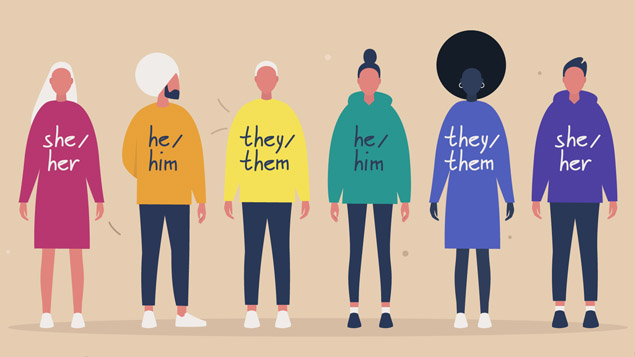Common Transgender-Relevant Questions, Answered: Ask Erik!

Hi readers! Welcome to “Ask Erik.” A safe, supportive environment where you can ask all the questions you have about the Transgender world. In this edition, we will be discussing often-misunderstood pronoun usage, guiding you in the best ways to understand identity, giving you some important tips to transition safely during the pandemic, and discussing ways to support gender-creative and expansive children. If you have a question for me don’t hesitate to send me an email and your question could be featured in our next “Ask Erik.”

Question: Dear Erik, I often see people in the community that use “they” as a singular pronoun. However, it has always been my understanding that “they” is plural. Why does “they” as a pronoun sound odd when used as a singular?
Answer: “They” can be used as a singular pronoun. The plural version of “they” did come into usage first, but the singular version has been in use since the 14th century. As for it sounding wrong to our ears, it is important to remember a lot of grammatically correct statements and phrases tend to sound a bit off because we don’t always speak or read perfectly proper English, and usage can change over time.
It’s respectful to use “they” when someone directly tells you that’s their preferred pronoun preference, or when you don’t know the gender of the individual that you’re referring to.
Pronouns are a polite way for us all to address one another without making assumptions or enforcing stereotypes of gender upon each other. The best advice I can give you is to keep practicing using “they” as a singular, and I’m sure it will be sounding correct in no time at all.

Q: Hi Erik! I just came out as trans and I want to start buying clothing in-person from stores. It’s a very scary and intimidating thought to me though. Is there any advice you can give me to help put my mind at ease?
A: Congratulations to you on both coming out and being ready to take such an important step! I remember my first shopping trips – some of them were very anxiety-inducing. It’s helpful to take a deep breath and remember that you have a right to clothing that makes you happy. It may seem at times like there’s an invisible keep out fence waiting to shock you if you enter the clothing section of your dreams, but the reality is that there isn’t.
If you have any close friends or family that you trust to go shopping with you – invite them along. It can be nice to have a visible ally who is invested in your goals and reassures you as needed. Look for stores that have gender-neutral fitting rooms if you aren’t quite ready to enter a specifically gendered one. Also, do a quick search online for the words transgender and store policies because some retailers have prioritized an open, safe, and comfortable shopping experience for anyone Transgender or questioning. For example, Macy’s and Target both have inclusive policies and training in their stores.
It may all seem new and overwhelming at first, but eventually, being in that part of the store will become second-nature to you.
If you would rather skip the cashier, opt for a self-checkout. Good luck! Remember that you aren’t alone – I’ll be rooting for you to get the outfit you deserve and want. Plus, a fun treat as a reward for all that hard work and anxiety never hurt anyone.

Q: Dear Erik, I have so many clothes from my assigned gender at birth and I’m finding it expensive to buy a whole new wardrobe. How can I transition my clothing without going broke?
A: Your question highlights a very real concern that isn’t talked about enough. It can be expensive to be Transgender! Particularly when we feel there is a whole list of things we want to do that are inevitably going to cost most of us money out of our pockets. You have most likely spent most of your life accumulating your wardrobe for your assigned gender at birth, so what’s a Transgender to do (other than write Erik for advice….!)
I would encourage you to prioritize pieces that will bring you the most joy and euphoria, first whether it’s skirts, slacks, or something else entirely. Zero in on what style you want your look to be and what pieces are going to best get you there. Second, basic pieces aren’t given nearly the appreciation they should be when it comes to versatility. Some of the best ways I get inspiration for outfits is to look up fashion pieces where one item of clothing has been styled in multiple ways. The more outfit combinations you can put together with fewer pieces or with colors and patterns that are multi-functional – the better for your wallet or pocketbook.
Don’t be afraid to transition your wardrobe slowly over time or to bargain hunt in thrift or secondhand stores. Clearance racks are often filled with treasures if you’re willing to look through the racks. If you are feeling dysphoric about pieces from your assigned gender of birth, I find it helpful to look at them without dysphoria coming into play as much. Put on an outfit and ask yourself if you looked the way you want to would the piece of clothing be something you would wear? If the answer is yes, then I opt to still wear it and try to ignore the criticism my brain is throwing at me. One last tip – allow yourself the freedom to experiment with new colors, patterns, looks, and textures. You are discovering yourself and in a whole new world of clothing. Embrace what brings you euphoria and you will be looking fabulous (and budget-friendly) in no time!

Q: Dear Erik, how do I begin to transition medically during this pandemic and what should I be concerned about? Is it even possible for me to start right now with everything going on in the world?
A: The pandemic is certainly making life interesting and challenging at times, isn’t it? The great news I have for you is yes! It should be possible for you to begin medically transitioning if you are ready and provided your area is not under any restrictions that would prevent you from doing so. When it comes to medically transitioning, I always recommend if you are using insurance to start with your insurance. It can seem intimidating to hop on a phone call to ask about providers and policies, but this is necessary to generate the most up-to-date information. However, another good place to start is by reading your actual policy that details and outlines everything that’s covered and what steps are needed (you may still need to call your insurance if you read something that doesn’t quite make sense to you). Insurance policies and companies are all individual and specific to both your area and purchased policy so it’s hard to advise you on what tests, pre-authorizations, or steps will be needed to start your medical transition.
A great resource that is not being utilized enough by the Transgender community right now is telehealth! Telehealth use can vary greatly depending on laws and may or may not be an option in your state (also, please note that usually, it is not possible to do every step online, but you may be able to do most of your care this way). There are even Transgender-specific telehealth companies that are Trans-owned and operated. How amazing is that?
As always, wear a mask, stay up to date on your local area for information, and keep in mind that things may go a bit slower than they would in normal pandemic free times. Try your best to be patient and remember that if any part of your transition is delayed due to circumstances outside of your control – it’s a temporary delay and in the best interest of your health and the health of those around you.
Increased self-care and affirmation may be needed if you experience such a disappointment during the process. No one can stop you from becoming who you are meant to be though – not even a pandemic.

Q: Dear Erik, my young child is starting to show signs that they are questioning and struggling with their gender identity. What is the best way to support a child that identifies as gender creative or gender-expansive?
A: The best thing you can do is what you’ve already done – you’ve acknowledged that your child is feeling gender creative and/or expansive. Gender is easy to take for granted when one feels like their identities align but difficult when the pieces of the mind and body aren’t on the same page. A child is a work in progress and a mini adult whose understanding of themselves and their environment may or may not change as they grow.
Let your child guide you with who they are and try to avoid attaching labels that they don’t apply to themselves. All of us experience life differently and your child will let you know what aspects of their world aren’t working for them. Try to let go of any gender assumptions and biases that you may consciously or unconsciously have, expose your child to age-appropriate diversity, and don’t misgender them or tell their story without their permission (this includes outing them). Being informed and an advocate for your child is a must but not at the expense of the child’s sense of safety, security, and individuality.
Some parents who find themselves in this position find a lot of comfort in allowing their child to find friends with who are like-minded or as diverse as they are. Every child appreciates and deserves love, knowledge, and understanding, and I am sure you will do a fantastic job of exploring their gender with them and watching them grow.
About the author: Erik Summer is an out and proud member of the LGBT+ community who in the past has volunteered with Letters Against Depression. They’ve been happily married for nine years, prefer he/him and they/them pronouns, and live in Ohio with their wonderful husband Mark. In their spare time, they enjoy working for Shipt, spending time with their pets, and are always looking forward to where life will take them next. If you’d like to contact them their email is: [email protected]
